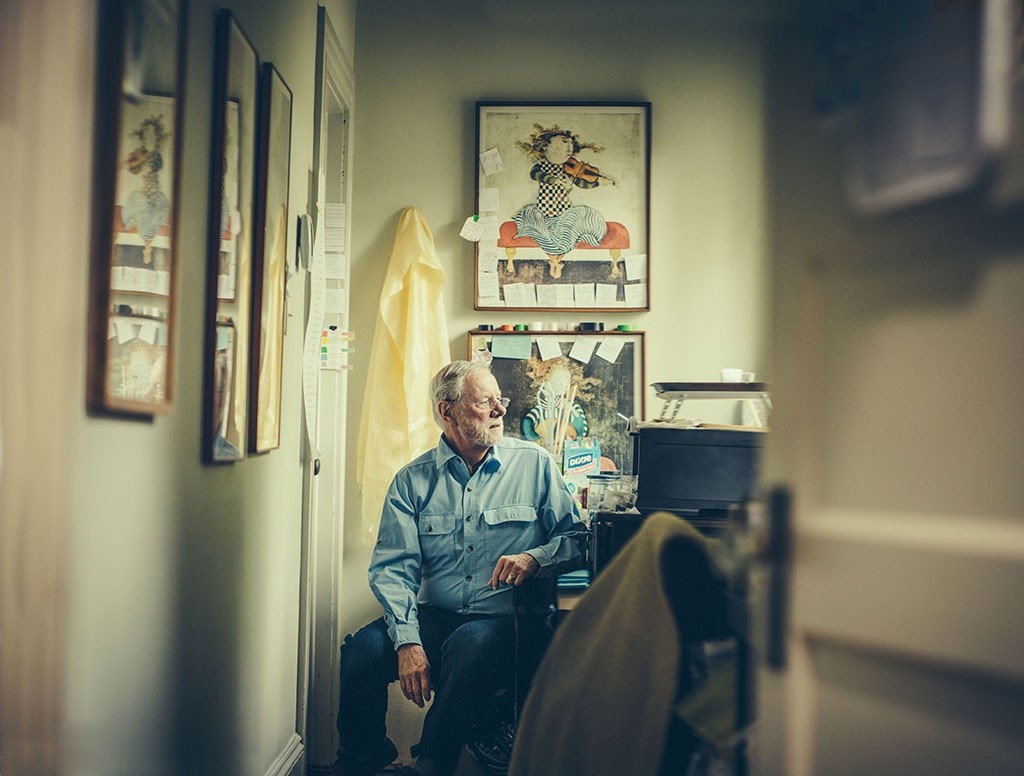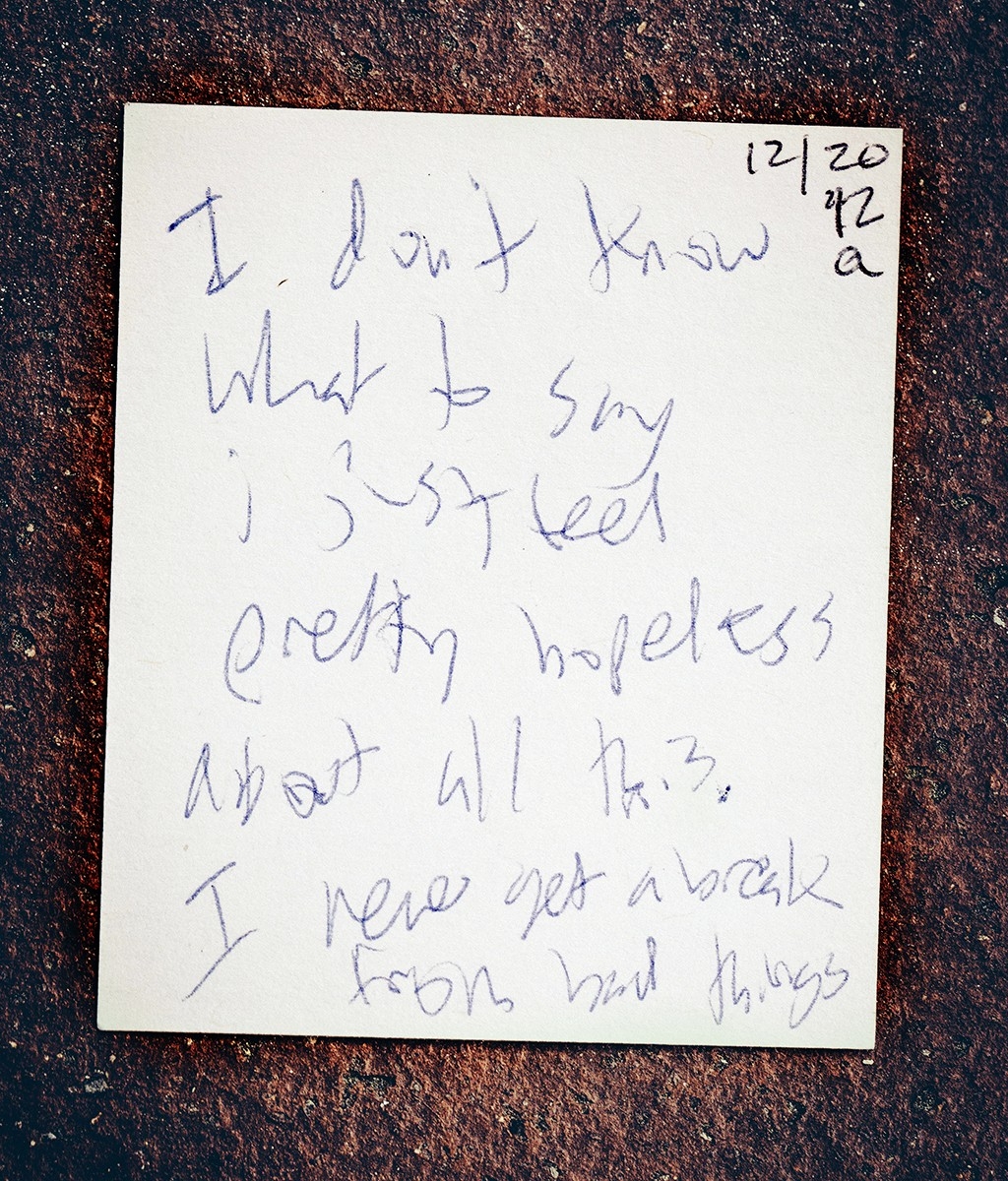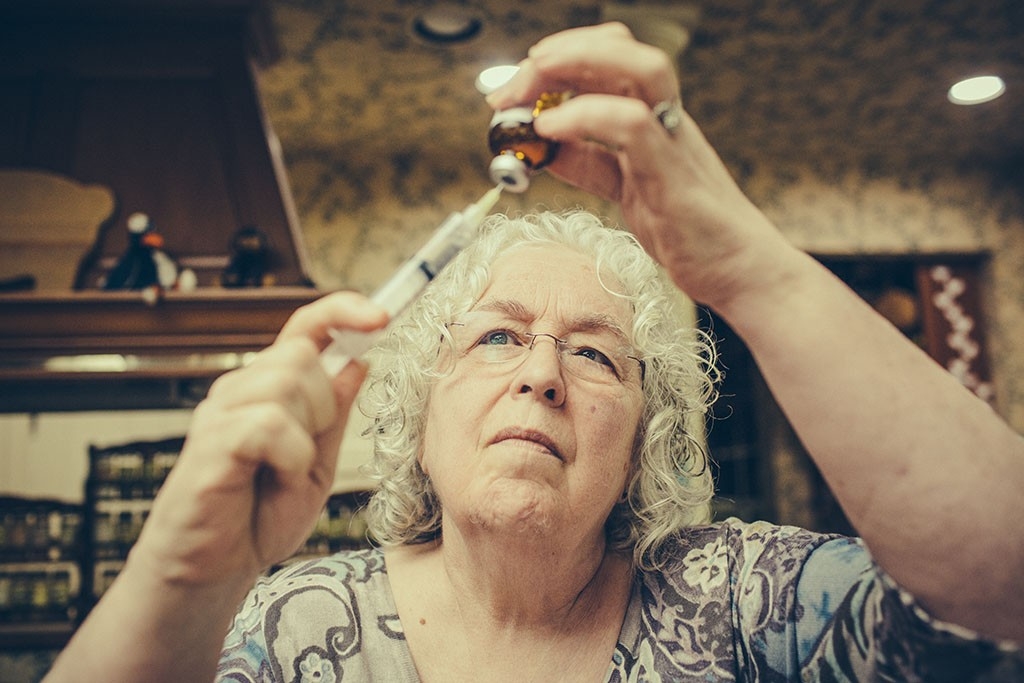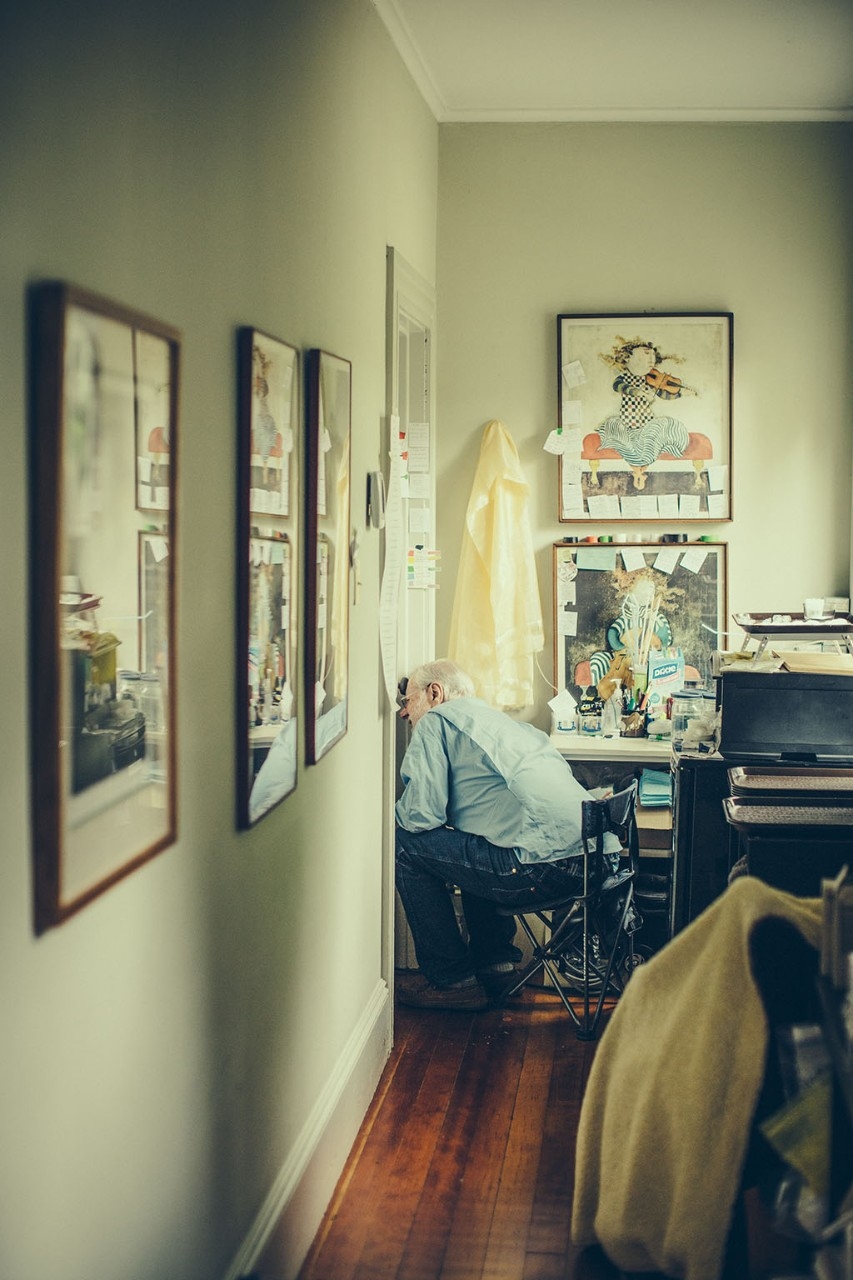The puzzle solver
A researcher changes course to help his son

For three years, Whitney Dafoe’s world has been a darkened room at the end of a hallway in the back of his childhood home. An insidious disease, one with no known cause or cure, has slowly stolen his life from him, turning his body into a prison.
He doesn’t eat. An IV line delivers nutrients and liquids and medicines to keep him alive. He doesn’t speak. He’s unable to write. Any motion exhausts him. Eye contact hurts him. He can’t bear to be touched.
Last December, in desperation, he used Scrabble tiles to communicate, laboriously lining them up to spell out: CANT TAKE CARE OF MYSELF; DONT KNOW WHAT TO DO. At the end of the month, emaciated due to his inability to digest food, he selected five final tiles and spelled out: D, Y, I, N, G. Then he rang a bell for his father.
Related reading
“My son Whitney woke me this morning to inform me that he is dying,” his father, Ron Davis, PhD, posted on the Facebook page for the Stanford Chronic Fatigue Syndrome Research Center that day. “Whitney has severe chronic fatigue syndrome (CFS). He did not say he is dying — he cannot speak. He did not write he is dying — he cannot write. He used Scrabble tiles to spell out his message. I did not answer him — he cannot tolerate anyone speaking to him.”
As paramedics wheeled Dafoe into the back of an ambulance that day, he opened his eyes, and for the first time in three years, stared awestruck at the wide, blue sky.
Each weekday, Davis, a renowned geneticist, takes a break from his job as director of Stanford’s Genome Technology Center, arrives home at 2:30 p.m. for his shift caring for his son, drops his comfortable, old, brown, brimmed hat on the kitchen counter and walks down the darkened hallway to his son’s bedroom door.
He doesn’t enter the room right away. Instead, he sits on a chair outside the door in the hallway, watching through a keyhole for Dafoe to find the strength to sit up and pull a blanket over his shoulders, signaling that it’s OK to come inside. Dafoe can hear Davis in the hallway. He knows he’s there. And slowly he prepares. Sometimes Davis waits, and he waits, and he works, and he thinks, and he puzzles over the mystery behind the closed door.
Over his 50-year career, Davis, a professor of biochemistry and of genetics at Stanford, has become one of the world’s pre-eminent solvers of what others call unsolvable puzzles. In 2013, The Atlantic magazine ranked him among the world’s greatest living inventors. His biotech methods helped launch the field of genomics, making terms like “artificial chromosomes” and “genome editing” part of the lexicon. A substantial number of the major genetic advances of the past 20 years can be traced back to Davis. And now, his research has expanded into a whole new arena — the search for a molecular cause for his son’s illness, and from that, a cure.
Davis is grappling with the most vexing puzzle of his life. And it’s personal.

Each day has become a race to unravel the mystery of chronic fatigue syndrome, the disease that is killing his 32-year-old son, a freelance photographer who was forced to move into his childhood home five years ago when he was no longer able to care for himself. It’s a puzzle that Davis ruminates over day after day, his mind humming along in high gear, constantly shifting through data, hypothesizing, analyzing.
At night, he dreams of science experiments. Each morning he awakes hopeful, with a new piece of the puzzle to fit into place, or an old one to throw out, and he heads back to work.
When you are a man of science, a world-class puzzle solver, how can you not solve this, the most important puzzle of all?
Chronic fatigue syndrome, also called myalgic encephalomyelitis or ME/CFS, is a disease that has baffled many, one that waxes and wanes, with no definitive tests for diagnosis, and symptoms that vary from patient to patient. Key to diagnosis is an inexplicable exhaustion that lasts for at least six months, and isn’t alleviated by rest. Unrefreshing sleep, unexplained pain in multiple systems of the body, cognitive impairments referred to as “brain fog” and digestive ailments are all common symptoms. And then there is “the crash.”
Laura Hillenbrand, best-selling author of Seabiscuit and Unbroken, who has lived with CFS for 29 years and spent many of those years bedbound, describes “the crash” — known in scientific terms as “post-exertional malaise” — as an invisible line you know is there, but you’re not sure where exactly. Any expenditure of energy, however slight — walking up stairs, say, or in severe cases like Dafoe’s, watching someone walk into your room — could push you over the line. Once that line is crossed, the setback can be devastating.
“The exhaustion is so profound it’s a struggle to breathe, a struggle to just lie there; it takes every effort just to stay alive,” Hillenbrand says. “This can go on for months or years. … You have to be so careful with every little bit of energy. You just don’t know what your line is.”
The inability to pin down the disease with a lab test and its often misleading name have resulted in patients getting labeled as malingerers or sent to psychiatric care by doctors who are unable or unwilling to help. The relatively small amount of federal funding has limited research to help find cures.

The National Institutes of Health allocated only $6 million in 2015 for research into CFS, which has roughly 2 million sufferers. (To put this in context, the annual NIH research budget for multiple sclerosis, with 400,000 sufferers, is $94 million.) A historical lack of acceptance within the medical establishment for CFS as a biological illness has resulted in a woeful underfunding of research, Davis says, but he notes signs of change.
Davis served on a panel convened by the Institute of Medicine (recently renamed the National Academy of Medicine) to redefine the illness. The panel’s report, published in February 2015, cemented the definition of CFS as a “serious, chronic, complex, systemic disease.” In turn, the report spurred the NIH to launch an internal study to analyze CFS biomarkers and promise to bolster research for this “elusive” disease. Most patients, including Dafoe, spend years undergoing fruitless tests and bouncing from doctor to doctor before finally getting a diagnosis.
“We don’t have a definitive lab test, so often the attitude is that these people are crazy,” Davis says. “Whitney was told that it’s all in his head, that he was just depressed.”
For Dafoe, the illness started more than a decade ago at 21, or possibly even earlier than that with a bad case of mononucleosis in high school, followed by a spell of headaches and dizziness after a trip to Jamaica during college. More signs of illness arose when he was 23. He’d been in India for several months when he began experiencing stomach pain, bloating and nausea. Two years later, he caught a cold and never felt normal again. He lost the strength to travel, he couldn’t set up his camera equipment, eventually he couldn’t prepare his own food, and digestive ailments made it difficult and ultimately impossible to eat.
Dafoe was an adventurer, the complete opposite of a so-called malingerer, says his sister, Ashley Davis. He traveled to all 50 states, studied Buddhism in India and Nepal, ran a campaign office for Barack Obama and took photos at his first inauguration, lived with a shaman in the Ecuadorian rainforest, helped build a nunnery in India, rode a motorcycle in the Himalayas.
But by 2013, Dafoe had become bedbound. Pain in his legs when he walked had hobbled him. In his last entry on his photography website, in June of that year, he wrote:
Really sick. I can’t talk. Can’t type/text enough to communicate. Haven’t had a conversation with someone in six months… To die of this illness is atypical; however, to hover in an in-between state where one experiences a ‘living death’ for years or decades is quite typical.
That was three years ago. Since then, Dafoe’s condition has steadily declined.
Since Dafoe was an infant, his family has lived in an elegant, old, brown house in the Palo Alto neighborhood known as Professorville, a short distance from the Stanford campus. Bright Buddhist flags decorate the semicircular porch in the daylight hours and twinkling white lights strung across the front yard brighten it at night.
It’s a large house overflowing with a lifetime’s worth of science books, much-loved paintings, Dafoe’s award-winning photographs — decor that tells the stories of the two now-grown children — Ashley, once a ballet dancer, and her older brother, a Little Leaguer. (Their parents decided to share their last names between their children, the mother’s to Whitney, the father’s to Ashley.) Author Gertrude Stein’s brother once lived in the home, starting a history of opening its doors to charitable and political events — one that the fit the family well. Ron and his psychologist wife, Janet Dafoe, PhD, kept their doors open wide to new ideas, to debate — politics, philosophy, science, medicine. Friends. Family.
But the house has grown painfully quiet in the years since their son moved back in. A hand-scrawled note taped to the front door explains: “Please do not knock or ring bell before 3 p.m. Call or text. Very sick person.”

Inside, the back of the house has become a hospital wing for Dafoe.
The family did reopen its doors last summer, holding a CFS fundraiser that drew about 100 people, including the mayor of Palo Alto, and plenty of media attention.
Every member of the family — led by Dafoe when he still had the strength — has become a CFS activist, fundraising for research, improving public awareness of the disease, doing media interviews and supporting Davis in his mission to find a cure.
“Ron feels a huge amount of responsibility and stress,” Janet Dafoe says, adding that her husband had an aortic valve replacement in December 2015, returning to his research as soon as he possibly could. “He also has to keep all his other grants up. He spends all the waking hours he can thinking about CFS research.”
In 2013, Davis launched the Stanford Chronic Fatigue Syndrome Research Center, which operates within the Stanford Genome Technology Center. As director of the scientific advisory board for the Open Medicine Foundation, whose mission is to find a diagnosis, treatments and a cure for CFS, he assembled a team of scientists from Stanford, Harvard and other institutions and helped the foundation raise more than $2 million in donations. The donations enabled the team in February to launch a “big data” study of 20 homebound patients with severe CFS. He’s brought together some of the world’s top scientists for a think tank to work on the problem, among them Nobel laureates Paul Berg, PhD, professor emeritus of chemistry at Stanford, and James Watson, PhD, chancellor emeritus of Cold Spring Harbor Laboratory; and Stanford colleagues Craig Heller, PhD, professor of biology, and Michael Snyder, PhD, chair of the genetics department.
But progress toward discovering a cure, or even a cause, for CFS is moving far too slowly for a father whose son is critically ill. Like other scientists who enter new research territory to help a loved one, Davis is pushing particularly hard for results. Twice he has submitted applications for CFS research funds to the NIH, without success.
“It’s enormous pressure,” he says. “We have to figure this out very quickly, because millions of people are suffering and my son is dying.”
To imagine the state of Davis’ mind when he’s thinking about CFS, it helps to look at a complex chart stored on Laurel Crosby’s computer in the basement of the Stanford Genome Technology Center. Crosby, PhD, an engineering research associate who works in the Davis lab, has spent three years attempting to deconstruct Dafoe’s CFS symptoms into molecular mechanisms. The chart is a depiction of the key biochemical processes at work in Dafoe’s body. It resembles an enormous dot-to-dot puzzle gone awry. All the lines are connected but no picture emerges. Now imagine this enormous dot-to-dot puzzle, called a human metabolic pathway chart, rotating in three dimensions. It’s this structure that is constantly whirling in Davis’ imagination. He’s searching for gaps, for missing pieces, for answers.
“This is Whitney’s biochemistry written out,” Crosby says, pointing to the computer screen. “You can see evidence of vitamin and nutrient deficiencies because he’s being fed intravenously. You can see deficiencies in metabolites that are supposed to go to make energy. The question is whether the machinery is inherently broken, or the system is just out of gas.”
“If you look at Whitney’s metabolic testing, it’s amazing that his body works at all,” Davis says. Of the 700 measurable biochemicals or “metabolites” plotted on the chart — including amino acids, carbohydrates, lipids and nucleotides — Dafoe has abnormal levels of 193. “Maybe low metabolite levels are keeping him sick?”
Like Crosby, Davis thinks the energy production system holds a promising clue. He spends a lot of time pondering the inability of the energy-producing structures within his son’s cells, the mitochondria, to do their job.
“Everything points to dysfunctional mitochondria,” Davis says. “But what is the molecular reason for the dysfunction? Given that there are over 1,600 genes involved in the workings of mitochondria, finding what’s wrong is a daunting task. Some kind of infection or trauma or stress might trigger a series of events that causes the body to go into an altered state.”


Davis suspects the answer to the CFS riddle lies somewhere in its molecular underpinnings. In his lab, researchers are looking for answers in the metabolic system. But he’s exploring all possibilities; other scientists he’s recruited — from Stanford, the University of Utah, Harvard University, the University of California-San Diego and other schools — are lending their expertise to investigate other systems of the body, including the immune system and the nervous system. So far, Dafoe’s blood samples are guiding this exploration — his entire genome has been sequenced.
“New technology is allowing us to cast a really big net,” says Mark Davis, PhD, professor of microbiology and immunology at Stanford, who is scanning Dafoe’s infection-fighting T-cells for abnormalities, as well as looking at other aspects of the immune system. “Some would call it a fishing expedition. But fishing expeditions also catch fish.”
The hope is that results from the newly launched trial of 20 severely ill CFS patients from Open Medicine Institute in Mountain View — a medical group practice that conducts research and provides care for patients with chronic illnesses — will increase the size of the net.
“You could say Whitney has been the inspiration for this study,” says Andreas Kogelnik, MD, PhD, an infectious disease specialist and director of the Open Medicine Institute. The study entails going into the homes of the patients to collect biofluid samples — the easily accessible ones like blood, urine, saliva and stool — then comparing them with those of healthy control subjects. This group of CFS patients, who have not been studied before because they are so hard to reach, is likely to show the strongest molecular signals of the disease, Ron Davis says.
Kogelnik, who treats Dafoe and hundreds of other CFS patients, knows firsthand how difficult it is to get research funding for the disease, and how difficult it is to treat patients. Getting someone of Ron Davis’ stature to bring his influence and attention to this disease has made a difference, Kogelnik says. Not only has it helped raise money for this particular study, it’s helped lend legitimacy to a disease that struggles for acceptance. Davis’ technological inventions that have helped shaped the field of genetics over the past 20 years will also make a difference, he says.
“This gene chip was designed in Ron’s lab,” Kogelnik says. He’s in his Mountain View lab, holding a thin, rectangular DNA microarray, or gene chip, between his thumb and forefinger. The gene chip is a collection of microscopic spots of DNA attached to a solid glass surface. It has on it an array of 70,000 different gene components, Kogelnik says, which will allow researchers to test which genes are turned on or off in a specific DNA sample applied to the chip. This technology will be used to test the biofluid samples from the 20 patients in the CFS study. Those results will be shared with CFS researchers. Davis’ inventions have come full circle, returning to help him discover a cure that could save his son.
One recent afternoon, Davis is sitting behind a desk in his office at the Genome Technology Center, preparing to drive home for his afternoon session of caring for Dafoe. He’s dressed in old jeans and sneakers; his gray beard, glasses and kindly demeanor lend him a grandfatherly air. The old, brown hat waits for him on the desk.
But Davis wants to take a moment to tell a story about his childhood. It’s a story of hope. As a boy, Davis used to buy chemicals at the local drugstore to make fuels for the rockets he’d shoot off in the field out back of his house in a rural area of Illinois. Though he had dyslexia, and his teachers and father told him he’d never be college material, he knew his brain could do some pretty cool stuff. At 14, he would sneak into the local college library at night to read chemistry and physics journals, and he’d get his older sister to teach him the advanced math she was learning in school, partly so he could make better fuel for better rockets, but mostly just for fun.
It was a chronic illness — one that left him bedbound for much of his childhood — that ultimately changed the course of his future, diverting him away from rocket science into medicine. Davis contracted a case of rheumatic fever when he was a year old that never really went away. It recurred maybe 200 times during his childhood in the form of strep throat, bringing with it high fevers, painful swollen joints and inflammation. Trapped in bed, Davis would play mind games to distract himself from the pain and the boredom. He’d dream up new three-dimensional worlds to escape into.

“I’d imagine myself being outside of my body,” he says. “Once I got there, I could go anywhere. It was so real. I could explore the room like an ant. I could slip inside the wall plug and explore the circuits. It must have been some kind of self-hypnosis. It required me to create images in 3-D. I’d rotate things in my brain. Anything spatial was always very easy for me.
“One day, I was absolutely miserable with a high fever. The country doctor came in with his little black bag and said, ‘I have something new.’ That sure made a big impression on me. He injected me with penicillin. Half an hour later, it was just like a miracle. I was completely better.
“I thought, oh my gosh, medicine can do this? And it’s a new technology. It set my course right then.”
At 2:30 in the afternoon, Davis arrives back at home, drops his hat on the kitchen counter and walks down the darkened hallway once again to take up his post outside his son’s bedroom door. These shifts provide his wife a much-needed break in her nearly round-the-clock care of their son. As Dafoe has grown sicker, the boxes of syringes and medicine bottles in the kitchen have multiplied. Nurses and home health-care workers constantly come and go. The acrid smell of antiseptics fills the room. Ashley, an emergency medical technician, cared for her brother full-time for about a year after she graduated from college. She still helps out as much as she can, aids in emergencies, stays over with her mom when her dad travels and brings her parents food.
Janet Dafoe has saved dozens of notecards written by her son from his sickbed when he still had the energy. In January 2015, he tried to explain to his parents what it was like when they entered his room, why it took him time to prepare. He wrote:
Someone in room feels like wind is blowing THROUGH me pulling me away like I’m made of sand and getting blown away… Draining but it goes deeper than it should. There is no part of me that is safe from it. I think it’s just because of how little energy I have. When I’m alone I can ration it and think slow, use less mental energy…
And so Davis continues to sit in the hallway, waiting for the signal to enter.
“Once you come in the room he just totally doesn’t move at all,” Davis says. Dafoe wears headphones to block out any sound. He hides his eyes under the bill of his cap. “He doesn’t see you but he knows you are there. I don’t know what he does to keep from reacting.
“He spent a year in India. He was fascinated with the Buddha. That’s what makes me think that possibly he’s meditating to manage the pain and isolation,” Davis says. Those brightly colored Tibetan prayer flags decorating the porch were brought back from Dafoe’s trip to India.
Since Dafoe’s ambulance trip to the hospital in December, his parents have been trying to add nutritional supplements to his diet through a feeding tube implanted in his gut to wean him off the IV and add missing metabolites. So far, his body has rejected most attempts at adding food supplements; they cause unbearable stomach pain and nausea. But his parents remain hopeful.
“Looking at his lab tests, he’s unbelievably strong to have all these things wrong with him and still be alive,” Davis says.
“I have a lot of respect for him,” Davis says. He knows of other severely ill CFS patients who have killed themselves. But Dafoe is committed to doing whatever he can to help find a cure for CFS.
“He’s hoping to do this for everyone with CFS,” Davis says. Then he pauses. “I told him it would take a while.”

